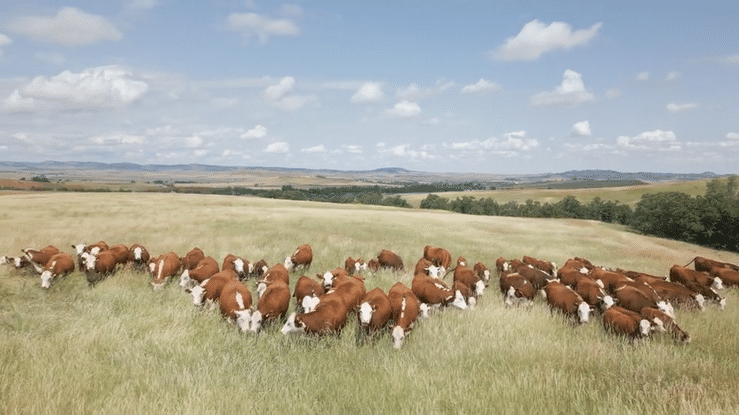
Nov 13, 2024 Bird Flu Infections in U.S. Dairy Herds Raise Human Health Concerns as Cases Rise
Video Credit: Sven Ole Brandt, Shutterstock
Recent news articles have highlighted concerns about bird flu following a report of human infections from Colorado and Michigan. A study by the Centers for Disease Control (CDC) randomly sampled 115 individuals working in dairies. The results showed that 7% of the sample (8 individuals) had experienced infections related to bird flu. Among these eight cases, only four reported feeling ill and exhibiting mild symptoms, such as red and itchy eyes. However, these eight cases likely represent just a small portion of a more significant issue.
The virus is believed to have unexpectedly jumped from birds to cattle in the fall of 2023, but it was not detected in cattle until March 2024 on a Texas dairy farm. According to the most recent data from the U.S. Department of Agriculture, the virus has now infected 473 dairy herds across fifteen states, including California, the largest milk producer in the country.
The latest data from the CDC reports 46 confirmed human infections with bird flu. However, the recent CDC study in Colorado and Michigan suggests this figure is likely a significant underestimate. There are thousands of dairy workers in the fifteen states where bird flu has been confirmed in dairy herds.
The current global bird flu (H5N1) panzootic, the animal equivalent of a pandemic, began in 1996 in China and has since spread worldwide through migrating wild birds. In 2022, 67 countries across five continents reported outbreaks of Highly Pathogenic Avian Influenza in poultry and wild birds. As a result, more than 130 million domestic poultry either died or were culled in efforts to control the spread of the disease. In 2023, an additional 14 countries, primarily in the Americas, reported new bird flu outbreaks.
According to a recent issue of the journal Science, strict avian control measures are in place in the USA and the EU to combat poultry infections caused by bird flu. When an infection is detected in even a single bird on a poultry farm, local health authorities must cull all the birds on that farm and restrict the movement of any infected biological materials.
However, similar measures have yet to be implemented to prevent the movement of potentially infected cattle between states or even to test whether the cattle being transported are infected. While it is recommended to dispose of biological materials from infected cows, such as milk, this practice is not mandatory. Fortunately, the FDA has confirmed that pasteurization effectively inactivates (kills) the virus found in milk. Despite this, as noted in Science, California has not banned raw milk consumption, even after bird flu was detected in 259 dairy herds throughout the state.
In its October 21, 2024 issue, Vanity Fair published a lengthy article discussing what it described as the “bungled bird flu response,” suggesting that profits collided with public health. The article, authored by Katherine Eban, reported that after the initial diagnosis of bird flu in a Texas dairy herd on March 25, 2024, the U.S. Department of Agriculture imposed what amounted to a gag order on its employees. The department allegedly followed a “don’t test, don’t tell” policy regarding the situation.
The Vanity Fair article concludes that as the avian flu virus continues to spread and evolve—potentially into a version that can be transmitted between people—it could lead to a confrontation as intense as the ongoing debate over who should be held responsible for COVID-19.
The COVID-19 virus has been referred to as the “$16 trillion virus.” The risk that the Highly Pathogenic H5N1 avian flu virus could mutate into a form that transmits directly from human to human is no longer as low as it once was. According to a recent article in Nature, the authors note that “the virus has sustained mammal-to-mammal transmission in multiple settings, including European fur farms, South American marine mammals, and US dairy cattle, raising questions about whether humans are next. Historically, swine have been considered optimal intermediary hosts that help avian influenza viruses (AIV) adapt to mammals before jumping to humans. [Recently, bird flu has been confirmed in one pig on a small farm in Oregon.] However, the altered ecology of H5N1 has opened the door to new evolutionary pathways. Could dairy cattle, farmed mink, South American sea lions [and now a pig in Oregon] serve as new mammalian gateways to humans?”
The CDC still reports low human risk from the current bird flu panzootic outbreak. However, the likelihood that the virus will mutate into a strain capable of human-to-human transmission is steadily increasing. As Tom Peacock, a virologist at the Pirbright Institute in the UK, points out, the risk remains low “until it suddenly isn’t.”
Currently, the bird flu virus has multiple mammalian reservoirs where it can continue to infect other mammals and potentially mutate into a form that spreads among humans. If (or when) this occurs, recent efforts to safeguard the $100 billion U.S. dairy industry by not imposing strict restrictions on the movement of untested dairy cows may, in hindsight, be viewed as a classic case of being penny-wise but pound-foolish.


